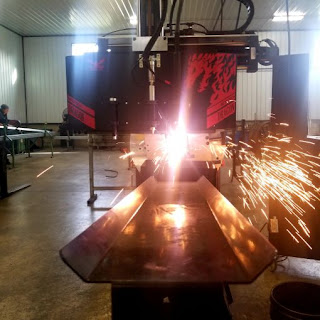 |
| Dragon Plasma Cutter |
This is accomplished by a compressed gas (oxygen, air, and others depending on material being cut) which is blown through a focused nozzle at high speed toward the work piece. An electrical arc is then formed within the gas, between an electrode near or integrated into the gas nozzle and the work piece itself. The electrical arc ionizes some of the gas, thereby creating an electrically conductive channel of plasma. As electricity from the cutter torch travels down this plasma it delivers sufficient heat to melt through the work piece. At the same time, much of the high velocity plasma and compressed gas blow the hot molten metal away, thereby cutting through the piece.
When working with steel tubing, plasma cutters that are built with a CNC table can dramatically increase production because of the ability to make quick work of precise cuts. Used in the processing of tube, pipe or any form of long section. The plasma cutting head usually remains stationary while the piece is fed through, and rotated around its longitudinal axis. There are some configurations where, as with 3-dimensional plasma cutting, the cutting head can tilt and rotate. This allows angled cuts to be made through the thickness of the tube or section, commonly taken advantage of in the fabrication of process pipework where cut pipe can be provided with a weld preparation in place of a straight edge.
Ohio Galvanized Steel is proud to have introduced plasma cutting in their steel pipe manufacturing. The newest addition to the OGT fabrication family, a new CNC Plasma Machine can cut holes, copes, angles, special designs, and more into tubes up to 6” rounds, 4” squares, and 2” x 4” rectangles. With this new machine, they are able to cut tubing up to .75” thick, meaning more precise cuts and angles for better quality products for their clients. Ohio Galvanized Steel has been producing high quality products for greenhouses and solar panel supports since 1990.
Comments
Post a Comment